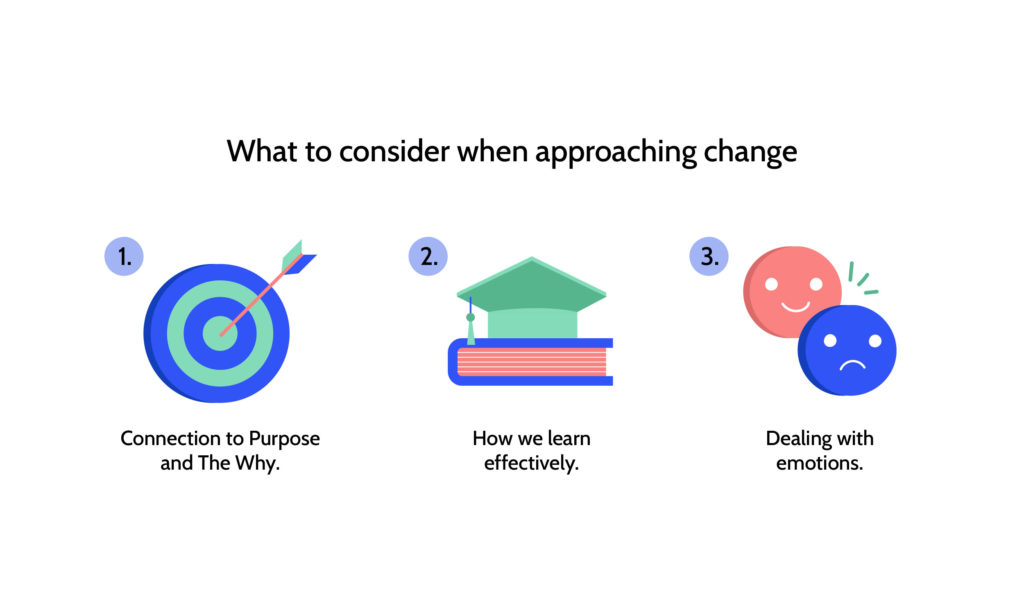It’s great to recognise the importance of change management to hit your strategic goals. There is more to it than project management spreadsheets and scripted regular updates on technical releases.
One of my clients provides an excellent case study of what happens when there isn’t a change management strategy, and how turn the ship around to make your strategic goals a success.
In order to lift the strategic capability of their team, Sam could see the technology that enabled them would need to change. What was on the surface, a simple, out-of-the-box, “best practice” digital platform began being built.
Sam recruited team members to be part of the design configuration and to be the go-to subject matter experts. Sam also engaged the software provider to conduct technical training, this was recorded for team members to play back as they needed.
![]() Include the team
Include the team
![]() Recruit change agents
Recruit change agents
![]() Provide training
Provide training
![]() At the end of phase 2 of 3, the adoption rate of the new technology was very low and the team were stuck on nitty-gritty items about how the workflow was happening in the tool. Despite the workflow being same as the teams’ current processes, just digital.
At the end of phase 2 of 3, the adoption rate of the new technology was very low and the team were stuck on nitty-gritty items about how the workflow was happening in the tool. Despite the workflow being same as the teams’ current processes, just digital.
This was surprising for Sam given the configuration of the tool was designed in direct response to the teams’ involvement.
The Missing Pieces in Change Management

1- Connection to the Purpose and The Why
I was invited into Sam’s project as the Change Manager when it was in its 3rd and final phase. While the project team and senior leaders understood the need for the change, this wasn’t called out to the team. The awareness of the core purpose and future vision and the “why” for this team was very low.
Sam was hoping that introducing technology modelled around “best practice”, that would automatically become the only option for the team. Boom, gaps in current ways of working, solved? Unfortunately not.
This is why when it comes to change management we are so often saying “it’s never just about the technology”.
How many times have we looked to technology to solve behavioural issues for us? To short-cut what feels most hard. Asking people to do something differently to how they are confident and comfortable doing it.
Whether you try to ninja it or dictate it with brutal force. If you’re asking for a change to ways of working then it takes clear vision and time in the front end. Even when there are “no-brainer” benefits that make logical sense. Teams need the future vision and the purpose painted honestly and frequently.
2- How We Learn Effectively
The next step in an effective change management, is a plan to build team capability and confidence to make the change. Once I was brought on in phase 3 for Sam’s team, we went about course-correcting the training strategy. (the one where there were 1-hour technical recordings team members could “choose” to playback as needed, you can imagine how in-demand this highly technical content was! *crickets*).
We needed to make hands-on learning experiences that tied the technical know-how back to commercial why. We also needed to create opportunities for practice/repetition and recall to make new information stick.
When it comes to training, it’s about building capability with brain-friendly learning. It needs to be structured to be practical and relevant to day to day work of the users. With repetition and recall built in for new info to stick. A one-off workshop will be quickly forgotten. It’s helpful if you can back these events up by providing repeated and ongoing, on-the-job learning moments.
Think about workshops you did a year ago or 6 months ago. How many of the key concepts and skills are you still practising now? For most of us we walk away with one core idea that resonated and lots of intentions. Learning needs to be more than one-off grand events.
3- Dealing With Emotions
Human relationships will always trump efficiency. We are emotional beings hard-wired for connection and acceptance. The most effective change management strategies address the behavioural skills that would hold someone back from pushing through difficult change. If your team knows how to use a system, great. But if they meet a stakeholder they can’t please, they will opt themselves out. Ending up doing labour-intensive workarounds and break from processes to protect their relationships. It will wear them out but they will find it hard to let that pay-off for that relationship go.
This means training plans need to include behavioural capability building. Skills and tools to guide a stakeholder through change such as:
- how to negotiate effectively,
- how to provide true commercial consultation vs. the inefficiency mentioned above to be perceived as “valuable”.
Give the team members confidence to execute beyond the technical. The result? adoption, and efforts spent on battles that propel you forward.
Making change is emotional not just technical, this is the part of being human, leading and working in a team that is the hardest part of any role.
Effective change management must be about change AND capability if it’s going to have lasting and meaningful impact
Where can your actions for effective change management start?
1. Engage motivation at it’s core
What the bigger purpose this change relates to? Why are we doing it? What will be possible in future as a result of this change?
Call this out honestly and frequently as the compelling why that will hold the whole team strong, particularly in the toughest phases of your change journey.
2. Take a human-centred design approach
When doing your training and capability planning, don’t just look at the technical training program, consider the behavioural capabilities your team will need in future when your strategic goal is successful. To do this I find a simple, user-centred approach is to map what the team think/feel/do now and what they will think/feel/do in future. Then you can see what behavioural skills you’ll need to upskill you team in to deal with any emotional barriers to the change.
3. Make learning brain-friendly
Look beyond the big ticket in-person workshops and map activities that create short and regular opportunities to practice new knowledge and skills on the job.
4. Prioritise leading change as core leadership skill to develop and imbed in yourself and your team
One place to start is the old pearl of wisdom “if you want to learn, teach”. Make part of the pilot and rollout strategies to have the team at the heart of the change, be the trainers for their stakeholders. Equip your leaders and have them in turn equip their teams with the key communication, dates, milestones and training resources + activities needed to bring stakeholders on the journey. Watch them embrace the change as the owners of it and strengthen their stakeholder relationships as their stewards of success.
Strategic goals demand stretch, change and certain levels of discomfort. If you want to win the motivation game to go the distance for your strategic goals you need to create the conditions, skills and support for the change to happen.
Having the capability for effective change to rise to these challenges is like building a muscle: you don’t just go to the gym for 6 months and that’s your body mastered for life. Change is a skill and a practice, it’s about behaviours and habits, this is a critical skill to build and keep practising at every level of leadership. If you rely on the tech alone you’ll be left with “less body mass”i.e. simplification, but also less muscle for the work of substance and impact.
When you’re ready to start levelling up your capability for effective change management, send us a note, and let’s explore how our Digital Smoothie experts can help you.
Enjoy Reading About Strategy & Digital Transformation?
Here are some articles that you might like:
It all starts with strategy – By Rania Awad





Leave a Reply